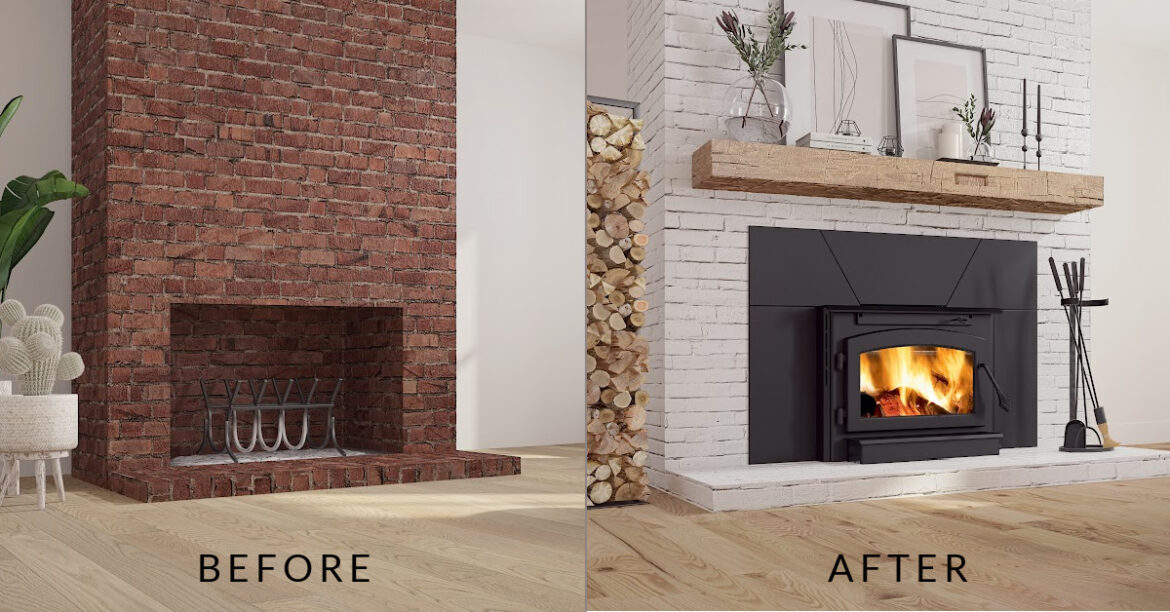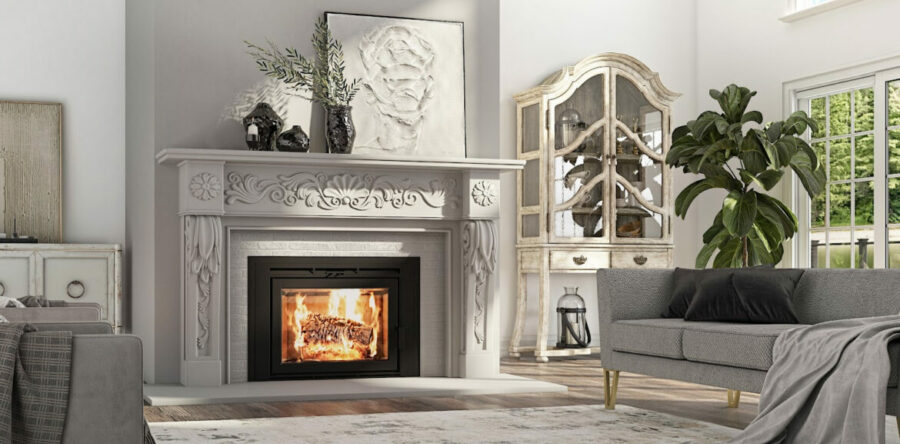[Note that this discussion is for a traditionally built, open burning, brick fireplace.]
You’re first thought might be, “Paint a brick fireplace? Are you crazy?” Why would anyone want to paint a fireplace? Several pretty solid reasons come to mind. Consider these:
- It’s an inexpensive way to give your fireplace an entirely new look.
- An easy way to freshen up the room when redecorating.
- It’s an effective way to clean up those dark soot stains.
- Maybe you’re updating the fireplace by adding an insert, gas logs and a new door.
- Perhaps you just want to change the color of an old, outdated brick.
In any case, the answer to the question: ‘can a brick fireplace be painted?’ is “yes, it can be successfully and safely done! It’s important to use the correct type of primer and paint. But first, it’s essential to correctly prepare the brick for a new paint job.
CLEAN FIRST & THEN INSPECT
Be sure you use protective eyewear and gloves. If necessary, use a stiff wire brush and thoroughly clean off any loose material from the brick and mortar. Then, dunk a coarse scrub brush in hot soapy water, dish soap is fine, and aggressively scrub the face of the bricks. The idea is to remove all dirt and any of the (efflorescence) white, powdery mineral deposits. WARNING: this is going to be a messy project so have plenty of old towels and rags handy! This first cleaning step is important because if any dirt is left behind, it may cause the paint to peel or chip.
If you have badly soot-stained brick and the soapy water doesn’t seem to be doing much, use a 1/3 vinegar to 2/3 warm water mix and scrub it again. It might be worth a try, depending on the severity, but sometimes Silly Putty pressed against the soot stain and then removed, will pull some of the soot from the deeper porous surface of the brick.
It’s worth noting here, that ventilating the area will be a good idea. These odors may be objectionable to some.
Another cleaning option for removing soot is to use ½ cup of trisodium phosphate (TSP) with one gallon of water. Liberally sponge this mixture into the brick and allow it to soak for 30 – 60 minutes. Then use the hot soapy water method described above. Check this article for more solutions to clean stubborn stains on bricks.
Once you’re satisfied that the brick is as clean as possible, let it thoroughly and completely dry out, for at least 24 – 48 hours.
After the brick has dried, carefully look over the fireplace for any small cracks. Fill any cracks with an acrylic caulk and let it completely dry.
IT’S PRIME TIME
Tape off any areas you want to protect and be sure to use a drop cloth to catch any splatters or drips. When painting brick, priming is important because it helps bond the final paint coat to the brick surface. Using a 1” or 2” brush, apply the primer to completely fill all the mortar lines. Be sure you use a concrete/masonry primer. It’s designed for porous brick. Then, simply use a roller with a ½” nap or more and completely prime the rest of the fireplace.
Once the primer dries, carefully inspect any problem areas that were encountered when cleaning. Areas that were heavy with soot or efflorescence would do well with a second coat of primer. Allow 12 hours or more for the primer to dry.
Now, you should be ready for the final coat of paint. Use a high quality acrylic latex paint that will be able to withstand temperatures up to 200°F. Most acrylic latex paints can tolerate 200°F, and your local hardware store can make a recommendation. You may also consider these suggestions from Bob Vila for choosing high-temperature paint for your brick fireplace. Make sure you paint the mortar joints with a brush and evenly roll the rest of the brick. As with all painting project, keep an eye out for any runs or drips. The paint color is your choice. Consider a flat or satin paint finish for best results.
WHAT ABOUT THE INSIDE OF MY FIREPLACE?
The process of painting the inside fire-brick of your fireplace is similar to the decorative brick described above. After removing the ashes, the first step is to thoroughly clean it following the process outlined above. Odds are though, you will probably do a lot more scrubbing and you will likely need to wash the inside several times with the TSP solution. Once clean, inspect the interior brick for cracks and decide if repairs are necessary. If you are planning to burn wood in your fireplace, a special 1200°F high temp paint will be necessary for the inside firebrick. A latex paint can be used if you are not planning on lighting any fires.
AMAZING!
You truly will be amazed how painting a brick fireplace can enhance the appearance of your family room. The brick is clean and blends with the walls, floor and furniture. Many people are amazed at how much more prominent the mantel seems. And there’s always the option of replacing the mantel with a new style. Those family pictures and mementoes will look great on a new mantel on a freshly painted brick fireplace. Santa’s going to be impressed too!












3 Responses